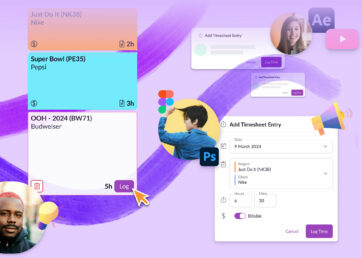It’s a universally acknowledged truth that a client-agency relationship is the cornerstone of any successful marketing scheme or advertising campaign. In fact, an r3 study reported that the top 40 client-agency relationships had an average relationship length of 22 years. (Wow!)
Yet the average length of a client-agency relationship in general is less than three years.
So what can you do to buck the trend and build a successful one? Keep reading to find out.
In this article 📖
What is a client-agency relationship?
A client-agency relationship represents the combination of creative chemistry and contractual obligations between a client and their agency of choice. The agency may be a broader marketing agency, or a specialist SEO, PR, social media, or advertising agency.
The agency’s responsibilities are usually defined, to some extent, within a contract. But the relationship is more complex than this. An agency-client relationship can be just as much about how you work, and who you’re working with, as the marketing results themselves.
Ultimately the relationship needs both parties to trust each other, and honestly want each other to succeed. Or as infamous account man, Roger Sterling, puts it in advertising drama Mad Men:
“Being with a client is like being in a marriage. Sometimes you get into it for the wrong reasons, and eventually, they hit you in the face.”
What is the importance of client-agency relationships?
In a world where technology moves at the speed of light the importance of client-agency relationships is becoming just as, if not more, valued than hard marketing expertise itself. According to an Aprais database of over 23,000 client-agency evaluations, over the last decade, clients’ expectations have changed to prioritize the quality of the working relationship over functional skills.
If a client-agency relationship isn’t working, then it makes the practical task of getting the job done and resource capacity planning a thousand times harder. What’s supposed to be a collaborative creative endeavor can become a workplace battleground.
4 core principles of client-agency relationships
We’ve ranked the key principles of client-agency relationships and outlined how you can improve them in your own client-agency relationship.
1. Transparency and accountability
In a 2022 study by Havas Creative, 80% of responders ranked “an honest relationship” as the most important behavior for a successful agency-client relationship.
An honest relationship requires both sides to be vulnerable, admit when they’re at fault, and be transparent in their feedback. Making sure your agency team structure allows for a single point of contact can help you achieve this, and improve your internal communication while you’re at it. Give your account managers the authority they need to be honest with clients and share in the wins and the losses.
2. Understanding
A client needs to believe their agency understands their:
- Business
- Brand
- Customers
As an agency, you can use your client’s own expertise to achieve this. Acknowledge they’ll always be the expert in their business, and encourage them to share their technical knowledge and research with you.
This doesn’t mean you can’t question or challenge the client’s views, particularly if you notice a disconnect between what the company values and what the customer wants. So long as you do so respectfully.
Speaking of respect….
3. Trust and respect
The Drum ranked trust as one of the top four behaviors clients value in their client-agency relationship. As an agency, you can generate and maintain trust by delivering work on time, doing what you say you’re going to, and achieving the outcomes you promised.
Simple, right? Well so long as you’re on top of your resource capacity planning.
Remember trust can also be built as a result of mistakes or “ruptures” in a relationship. If you miss a deadline, take ownership of it. Explain why it happened and how you’re not going to do it again.
4. Communication and process
You can’t have trust without communication. And you can’t have strong communication without ironclad processes and agency operations.
In fact, research undertaken by the University of Otago in New Zealand found that work patterns like “effectiveness of the meetings between the firm and the advertising agency” were perceived as vital by clients.
Answer the following questions and reflect on whether your current processes align with your answers:
- How often are you updating the client?
- How often do they want updates?
- Do you think your client’s feedback is honest?
- Where would they like updates? Slack, Email, Phonecall, Zoom, or IRL meeting?
Now, are you certain your clients would answer the same way? If there are discrepancies then there’s work to do on your communication skills.
“PR agencies sometimes accept work on a project or an account when they don’t have the resources required. This often means the agency team gets overworked and burnt out, which leads to sloppy work being submitted or deadlines getting missed. This has a knock-on effect on the client’s internal business, and of course tests the relationship. Resource management software can help alleviate this issue by properly resourcing accounts upfront.”
– David, PR/Comms expert (ex M&C Saatchi)
Resource Guru can help you build ironclad processes
Ever found yourself overpromising your agency’s ability to deliver because you don’t have visibility on your capacity? Our resource management software can give you a clear and quick overview of the skills and capacity available on your team right now.
Try it today with our 30-day free trial
Client-agency relationship stages: 4 steps to achieving long-term success
One of the most important parts of running a successful agency is pitching and winning clients. The other is retaining current clients.
An analysis of 151 client-agency relationships found that the criteria people used when choosing an agency partner were very different from the criteria used when deciding whether to keep one.
Learning to understand how to strengthen the relationship at every stage of the client and agency relationship life cycle may be the secret sauce to long-term success.
We’ve outlined four stages of the client-agency relationship below.
Stage 1: Inception
From prospecting to pitching, the inception stage of an agency-client relationship is all about first impressions. In fact, a study that analyzed 82 agency-client relationships found clients valued the “people factor” above all else at this point.
This includes traits like:
- Interpersonal relations
- Perceived creative ability of individuals
- Integrity and shared purpose
Put simply, at this point, clients are focusing on the nature of the project management team who would become responsible for their business, rather than the strategy and future plans for the business.
(Though, of course, both matter.)
At the inception stage of any client-agency relationship, put time and effort into building personal relationships and introducing the people who’ll be working on an account.
Stage 2: Development
So you’ve secured a new client: Hurrah! Now comes onboarding, setting the tone of your client-agency relationship and your agency workflow.
At this stage in the relationship, clients highly valued factors like:
- Trust
- Honesty
- Dependability
- Expertise
- Reciprocity
Simply put, clients are looking for commitment, and need to know the agency genuinely cares about them and the ongoing success of their business.
You and the client are moving through the honeymoon period into deciding whether this is a long-term relationship. And if you can make it past that 6-month itch.
Stage 3: Maintenance
Like all stable agency-client relationships, you’ll move into a maintenance cycle as you work through the various challenges, opportunities, and campaigns of agency work. This can be looked at as a repetitive pattern of discovery, briefing, implementation, measurement, and reflection.
During this stage, clients are looking for:
- Continued understanding of their business
- Information sharing
- Improved agency efficiency
- Results
Though results are important, satisfying clients is as much about giving them opportunities to learn and grow themselves. At the beginning of every new cycle of work, whether that’s on a quarterly or campaign rhythm, give clients the space to share what they want to learn for themselves, alongside business goals.
Stage 4: Dissolution or renewal
As you and the client work together you’ll inevitably face challenges. Your client-agency relationship will either come out of those stronger than ever or have lost faith in each other.
Some of the main reasons for losing clients include:
- Perceived lack of attention from the agency
- Failure to meet deadlines and solve resource management challenges
- Dissatisfaction with creative results
- Breakdown of interpersonal relationships
A big predictor of having an ongoing relationship, regardless of periods of unrest or challenges, is closeness. How frequently do you connect with the client? In particular face-to-face contact?
Regular, meaningful, and honest contact is the secret to ongoing renewal in a successful client-agency relationship.
Information regarding client-agency relationship responsibilities
Both parties in a client and agency relationship share the responsibility of nurturing that relationship. Though specific responsibilities will vary depending on the nature of the agency-client relationship, making sure everyone knows who’s responsible for what is a great way to start on the right foot.
Here’s Resource Guru’s suggested breakdown. 👇
5 factors affecting client-agency relationships
So what is the most critical factor in the agency-client relationship?
In a world driven by technological advancement and economic pressures, the landscape that an agency-client relationship works within is constantly evolving. These changes have a significant impact on client-agency relationships, so take a look at our top five factors to keep an eye on.
1. Conflicting and unclear expectations
A loose or poorly defined brief leaves a lot of room for ambiguity. This can make it even more challenging for agencies to understand and meet client objectives. At the start of every make sure you define:
- Desired objectives
- Budget
- Context
- Success metrics
- Project monitoring and control measures
Normalize discussing these with your clients, and don’t start work on a project until they’ve been defined.
“PR agencies can sometimes replace useful insights with vanity PR metrics in client reporting with things like “PR Value” or “reach around the coverage generated”. This is instead of looking at the number of people that actually read the article or the campaign’s societal impact with specific metrics like units sold, sign-ups, or conversions.
This can test a client-agency relationship, as the client often wants meaningful and actionable insights, rather than sugar-coating campaign results. It’s a good idea during the initial stages of the relationship and at the kick-off stage of each campaign to be upfront with one another to understand the metrics that the client is actually interested in seeing”
– David, PR/Comms expert (ex M&C Saatchi)
2. Unclear and inconsistent processes
Unclear and inconsistent processes erode trust in an agency-client relationship and will hinder your ability to collaborate effectively. When agreed-upon processes are not followed without proper communication, it creates mistrust and strains the relationship.
Maintain clarity and consistency in processes to build trust, increase productivity, and hit your targets.
3. Scope creep
Scope creep refers to uncontrolled growth or continuous changes in a project’s scope beyond its defined boundaries. Poorly documented or controlled project requirements lead to additional tasks, budget overruns, resource allocation issues, and project delays.
👉 Read our post on project scope to get 7 tips on how to avoid scope creep.
4. Budget pressures in an economic downturn
It’s not exactly news that everyone is tightening their belts. A 2023 digital agency report by Promethean stated competition among agencies is playing a role in the downward pressure on profit margins. As an agency, you need to be as efficient as possible and maintain a great client-agency relationship to manage the squeeze.
Efficient time tracking can help agencies navigate budget pressures and maintain client relationships. Consider utilizing software like Resource Guru for marketing agencies to make sure you’re making the most of your assets.
5. AI alignment
Conflicting AI alignment can pose challenges for client-agency relationships. If an agency focuses on human-centered creativity yet is working with an AI-obsessive CEO seeking extensive automation, aligning their objectives becomes difficult. Talk to your clients about how you’ll balance AI utilization and human creativity for the best results.
Client-agency relationship examples
Did you know that before they developed earworms like “I’m lovin’ it”, Mcdonald’s and Leo Burnett had been working together for almost 30 years? In fact, long-running agency-client relationships in advertising have led to some of the world’s most loved marketing campaigns.
Agency-client relationship in advertising
The importance of a strong client-agency relationship in advertising is clear. This arrangement needs to be a marriage built on creativity, innovation, and shared values. Let’s take a look at some of the titans of ad agency-client relationships.
Apple x TBWA\Chiat\Day
Apple and TBWA\Chiat\Day have worked together for over two decades, and their relationships have been instrumental in Apple’s iconic “Think Different” and “Mac vs. PC” campaigns. Apple’s co-founder Steve Jobs praised TBWA\Chiat\Day’s understanding of Apple’s brand essence, and ability to deliver messages aligned with Apple’s innovative spirit as cornerstones of their advertising agency and client relationship.
Nike x Wieden+Kennedy
Nike and Wieden+Kennedy’s advertising agency client relationship dates back to 1982. That’s over 40 years of working together to create Nike’s legendary brand image. “Just Do It” didn’t come out of nowhere. Wieden+Kennedy’s co-founder Dan Wieden once described Nike as a “dream client” as both companies are committed to innovation and pushing boundaries.
Client-agency relationship in PR
Client-agency relationships in PR are arguably even more important, especially when a crisis occurs and tempers fray.
These folks have managed to make it work, with a successful client-agency relationship spanning over 20 years.
Amazon x Weber Shandwick
Weber Shandwick’s long-standing relationship with Amazon has seen the launch of multiple new services and product launches, as well as managing Amazon’s corporate reputation, crisis communication, and stakeholder relationship.
All in a day’s work, eh? Amazon has praised Shandwick’s ability to convey its company’s mission and value proposition, as well as its expertise in navigating communication challenges.
Coca-Cola x Burson-Marsteller (now BCW)
Coca-Cola has long valued Burson-Marsteller’s strategic counsel and crisis management expertise. Meanwhile, Burson-Marsteller highlights the importance of storytelling and meaningful connection when it comes to working on Cola’s numerous product lines and sustainability efforts.
How to measure a successful agency-client relationship
If you’re in a client-agency relationship, it’s important to reflect at regular intervals. Monitoring your Net Promoter Score is a great way of keeping an eye on the general success of your client relationships. To check your NPS simply ask clients on a scale of one to ten how likely they are to recommend you to friends or colleagues. This is often done anonymously through an online survey.
Depending on the score they give you you can rank your customers as follows:
- Promoters are those who rate your services at a 9 or 10
- Passives are a score of 7 or 8
- Detractors are those who give you a score of 6 or less
To work out your final overall NPS score as an agency simply subtract the percentage of detractors from the percentage of promoters, and leave the passives out of it. According to Retently’s most recent survey, the average NPS for a digital marketing agency in 2023 is 53.
As well as measuring tangible success metrics, reflecting on less tangible qualities of a relationship can be equally important.
Try running a focus group with the key stakeholders who work on a certain client, and ask everyone to rank your agency and client relationship out of ten for the following questions:
- Do we have a deep understanding of our client’s industry, market landscape, and target audience?
- Are we proactively adapting our strategies to changing market dynamics and emerging trends, and communicating this to the client?
- Are we fostering long-term relationships with our clients based on trust, collaboration, and mutual respect?
- Are we continuously striving for innovation and pushing creative boundaries in our campaigns and strategies?
- Do we create space for our clients to give meaningful feedback without fear of reproach?
You could take it a step further and share your answers with clients to see whether they agree. If you notice low rankings coming from the client or your team, then it’s time to investigate further and draw up an action plan to turn the relationship around.
Great client-agency relationships take time
A great client-agency relationship is a marriage of equals based on transparency, a shared understanding of goals, and consistent processes. Reflecting on what stage of a client-agency relationship you’re in, and what the potential threats to that stage are, can help you strengthen the relationship, build trust, and stand the test of time.
Resource Guru can help you build trust with clients
Quality relationships start and end with trust.
Try out Resource Guru’s free, 30-day trial today so you feel confident you can deliver outstanding work on time to your clients.





